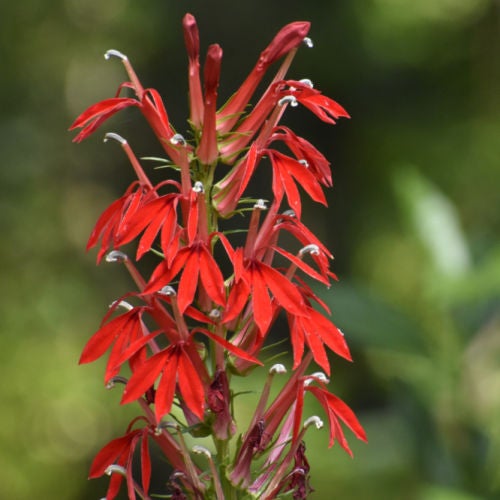Vibrant Beauty: A Deep Look at Red Cardinal Lobelia
Red Cardinal Lobelia's History
Red Cardinal Lobelia stands out because its extensive historical background corresponds to the vibrant complexity of its flowers. The first people to understand the plant's value were North American Indigenous peoples who utilized it both as medicine and in their sacred rituals. This plant held sacred status within Cherokee and Iroquois healing ceremonies since they used it to cure respiratory ailments. Healers created dried leaf teas from this plant to address congestion and respiratory illnesses such as asthma and bronchitis. The cleansing properties of this plant prompted its use in sweat lodges and herbal smoke treatments for body and mind purification.
European settlers adopted these practices following their observation of their effectiveness against respiratory and nervous system conditions. During the 18th and 19th centuries American apothecaries used it as an ingredient in their medicinal tinctures and tonics. The main benefit of this substance came from its capacity to stimulate sweat production and lower body temperature during fevers. Modern medical practices have given up using this treatment as its main application yet homeopathic herbalists still incorporate it.
Red Cardinal Lobelia A Stunning Addition to Landscapes
Throughout its medical history this plant has become the preferred option for both gardeners and landscape designers. This plant brightens garden spaces with its bold colors and upward-growing structure. Garden borders wildflower meadows and rain gardens benefit from the plant's tall flower spikes which create strong visual contrasts next to delicate colored plants.
The main benefit of adding this plant to gardens is its capacity to thrive under different environmental conditions. This plant thrives in wet soil conditions making it suitable for wetland restoration projects and rain gardens that require plants which can endure temporary inundation. The plant grows well near ponds and streams which makes it a popular choice for gardeners who plant it in moist low-lying garden areas. When provided with nutrient-rich soil and consistent watering along with proper maintenance this plant will thrive in standard garden beds.
This plant boosts biodiversity levels in its growing location. This beauty distinguishes itself through essential ecological benefits which are rare among ornamental plants. The plant produces nectar-filled blossoms which serve as an important food source for pollinators and keep insect visits consistent throughout its flowering phase.
Red Cardinal Lobelia's Striking Features and Appearance
This wildflower perennial displays a unique charm that surpasses most other plants. The plant achieves a height of four feet with lance-shaped green leaves from which dense bunches of tubular flowers emerge. The flowers present such a bold contrast against the background of leaves that they naturally capture attention. Flowers show unique structures that consist of elongated tubes which open into blossoms making pollinating insects access easy.
Red Cardinal Lobelia's leaves display a profound green hue and feature mildly toothed edges as they grow alternatively along a sturdy stem that lacks branches. During the growing period the leaves acquire a bronze hue which adds to the plant's inherent elegance.
What makes this plant stand out most is its exceptional ability to sustain its blossoms over a lengthy period. This spectacular perennial shows off its flowers continuously from mid-summer until early fall which makes it visually appealing for longer than most summer perennials. The flowers of this plant retain their bright coloration for extended periods when grown in well-drained soil with an abundance of moisture and natural sunlight.

This plant species attracts atypical specialized wildlife rather than usual garden pollinators. Among the plant's visitors the ruby-throated hummingbird holds the position of most significant visitor. These tiny bejeweled birds select these flowers for their tubular shape and deep color since the blooms provide essential nectar during their migratory seasons.
Red Cardinal Lobelia distinguishes itself from other nectar-producing plants as it serves as a crucial food source for fast-flying sphinx moths that hover mid-air like hummingbirds while feeding. Sphinx moths perform an essential pollination role during nighttime hours which enables plant reproduction to occur after dark.
Bumblebees often come to feed yet struggle to get to the nectar due to the flower's deep tubular structure. Certain bumblebees use their powerful mandibles to make openings at flower bases in order to directly access deep nectar. Although this behavior seems to be destructive it demonstrates the fascinating way nature adapts through plant-pollinator interactions.
Wildlife receives support from this plant through various methods besides pollination. Beneficial insects that control garden pests find food and refuge within this plant because predatory wasps use it as both a habitat and food source. The thick plant foliage acts as a protective home for small amphibians such as frogs and toads which thrive in its common moist habitats.
Its ability to support rare wildlife species along with its historical significance and medicinal background make this plant a pinnacle landscape addition that impresses with its stunning appearance. Whether grown in domestic gardens or naturally occurring in the wild this plant sustains its ability to captivate enthusiasts who appreciate both its visual beauty and its environmental importance.
For hundreds of years Red Cardinal Lobelia has preserved its importance for human culture and medical applications while existing in natural ecosystems. The plant remains a treasured selection among gardeners and conservationists who appreciate its lasting heritage that will endure for generations to come.